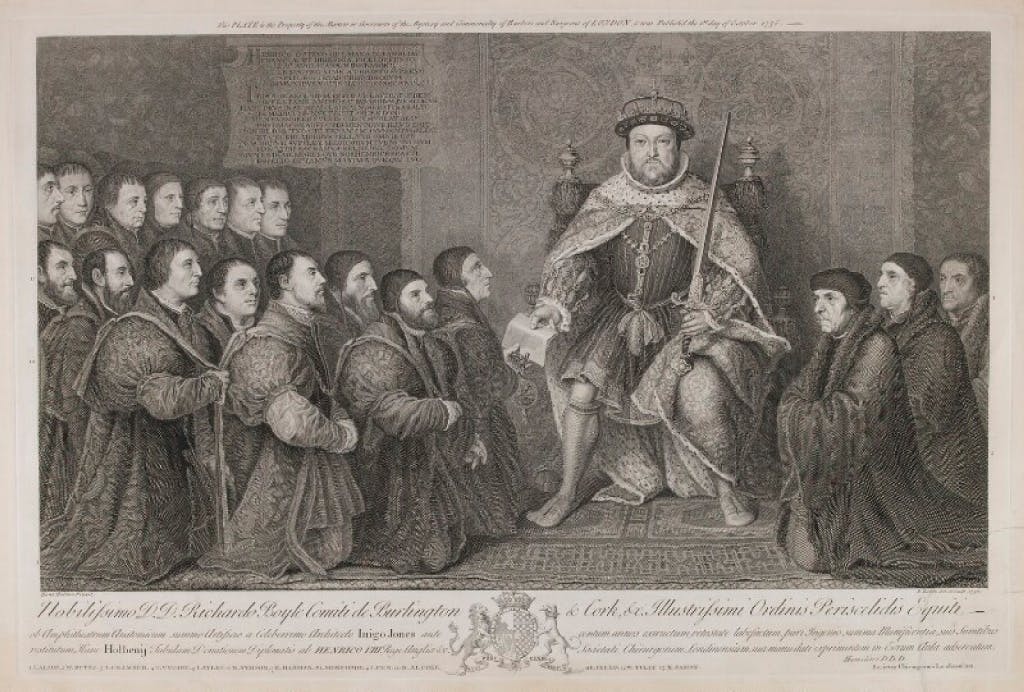The Weird and Wonderful Medicines of Henry VIII
Date: 12 January 2023
Author: Cara Gathern
Henry VIII is one of England's most famous monarchs, but lesser known are his numerous medical problems and the often-extraordinary remedies which he used to treat them.
Cara Gathern, a Techne placement student at Historic Royal Palaces, spent six months researching the private life of Henry VIII and his queens. Here, Cara explores this fascinating subject.
Injury and Illness
By the early 1540s, Henry VIII’s private moments must have been increasingly taken up with medical concerns. Henry suffered most chronically from painful leg ulcers, probably a result of a severe jousting accident in 1536. He also struggled with headaches, swollen ankles, constipation, and many other physical complaints.
Henry’s Book of Medicines
Henry VIII’s increasing preoccupation with his health is suggested by a handwritten book of remedies for medical treatments, which was created for the King between 1540 and 1545. It contains almost 200 recipes and many of them are recorded as being devised by Henry himself.
This book, held in The British Library and known as Sloane MS 1047, offers a fascinating insight into Henry’s health problems and the kind of treatments he relied upon.
A "Pusset Oyntment" for Skin Sores
The book records just two remedies created by Henry VIII himself whilst he was staying at Hampton Court Palace. One of them is a "Pusset Oyntment" (ointment) made to heal excoriations, or skin sores.
Image: Manuscript of medical recipes designed for Henry VIII. © British Library Board, Sloane MS 1047 f.57r

Take chamomile flowers, mellilote flowers, rose leaves, honeysuckle leaves – in the same amount equally. Boil these in water of rose and honeysuckle flowers as much as shall suffice, then strain, and take thereof – 1 ounce. Then take hens suett well washed with rose water of province more than luke-warm – 2 ounces. Then take litharge of gold – 2 ounces. Tutie (a crude zinc oxide compound) preperated (rinsed to purify), red coral, - in the same amount - ½ ounce. Pearls – 2 ounces. Unicorn horn 1 ounce. All these finely powdered, mixed with the decoction (medical preparation made by boiling), and hence, boil them until it be an unguent (an ointment).
'A Pusset Ointment devised by the King Majesty at Hampton Court to heal excoriations' (folio 43v)
Kill or Cure?
Some of Henry’s ingredients are poisonous, whilst others seem simply bizarre. Litharge of gold is actually a lead compound, named for its reddish-gold colour, whilst the 'unicorn’s horn' referenced in the recipe above was probably narwhal horn. Other recipes call for ceruse (white lead), nightshade and – a personal favourite – ‘long worms of the earth’ or as we know them today, earthworms.
Various non-toxic herbs and flowers, white wine and rose water are all also frequent ingredients in Henry’s recipes. The second recipe devised by Henry whilst he was staying at Hampton Court is a poultice, the ingredients for which include violet leaves, apples, mallow flowers, linseed, and a newly laid egg. This would have been a topical compound applied to the body on a cloth, possibly used to treat Henry’s leg ulcers.
Private Practices
Although the pain caused by Henry’s legs was public knowledge, medical treatment probably took place in the King's private apartments.
A Tudor medical text by one of his nurse-physicians, titled Bullein’s Bulwarke of Defence against Sickness and Disease (1562), repeatedly urges patients to lie upon their bed when receiving topical treatments – including a treatment for swollen legs. Among the numerous medical recipes in Bullein's Bulwarke is this particularly strange 16th-century recipe for Oleum vulpinum, or fox oil:
Take a whole Foxe, except the bowels, and put hym in a vessel, and powre uppon him Welle water, and salte Water, [and] old oyle. Seeth thys over a softe fyre, with Salte untyll the Water be consumed. Then put it into a vessel and powre to it sweete Water, wherein the herbes were sodden and […] seeth them again, till the Water be consumed.
Possibly one of the more disturbing recipes in Bullein’s book, this Oleum Vulpinum was recommended as a remedy against arthritis, back pain, and gout. Henry himself suffered from gout and may possibly have used something like this when under the care of Bullein.
A Daily Struggle
Other recipes in the Sloane manuscript suggest the extent to which Henry's illnesses and treatments punctuated the waking hours of his later life. One anonymous remedy from the book advises the King to apply the mixture to his swollen legs by warming it and 'with sponges make fomentation [a heated pad] thereof evening and morning'.
Henry was also known to have his ulcers lanced regularly by physicians who believed it safest to keep them open to the air, and to receive enemas for bowel problems. An enema or 'Clister' recipe from Bullein’s Bulwarke recommends combining dill oil, white wine, chicken, and duck grease, butter, egg white and cassia fistula plant, to be inserted into the rectum using an animal bladder.
Image: Chamomile flowers. Chamomile flowers are a common ingredient in Henry VIII’s medical remedies. They can now be found growing in Chapel Court at Hampton Court Palace.


A Tantalising Glimpse
We can never know the full extent of Henry VIII’s medical concerns. His doctors left no official records of what was ailing the King at which periods in his life. What we do know is pieced together from books such as the manuscript of medical recipes designed for the King and from the few state papers which reference his illnesses.
Yet the manuscript can offer us a tantalising glimpse into the private world of Henry's later years. It suggests a day punctuated by medical care and offers us a deeper understanding of the late King as a sick man, who struggled so much with his health that he devised his own pharmaceutical remedies in his spare time.
Image: Portrait of Henry VIII dated 1544. © Historic Royal Palaces
Cara Gathern
Techne Placement Student, Hampton Court Palace
This blog was written as part of a placement funded by the Techne AHRC Doctoral Training Partnership. HRP’s partnership with Techne forms part of our role as an Independent Research Organisation.
Suggested Further Reading
C. R. Chalmers and E. J. Chaloner, ‘500 Years Later: Henry VIII, Leg Ulcers and the Course of History’, Journal of the Royal Society of Medicine 102(12) 2009, at PMC.
More from our blog

Elizabeth I: History's Healthiest Monarch?
15 January 2024
Elizabeth I was top of the Tudor tree when it came to health and fitness. Always a resourceful woman, she chased away ‘melancholy’ with a whole host of entertaining pursuits.

Secrets of Henry VIII's Whitehall: The Archaeology of a Lost Palace
17 August 2023
More than 300 years after the destruction of Whitehall Palace by fire, archaeological excavation and scientific analysis continue to uncover the lost stories and secrets of Henry VIII's once elaborate home.

Elizabeth I’s coronation procession from the Tower of London
17 November 2022
Curator Charles Farris recalls Elizabeth’s dramatic procession from the Tower of London to Westminster the day before her coronation.

